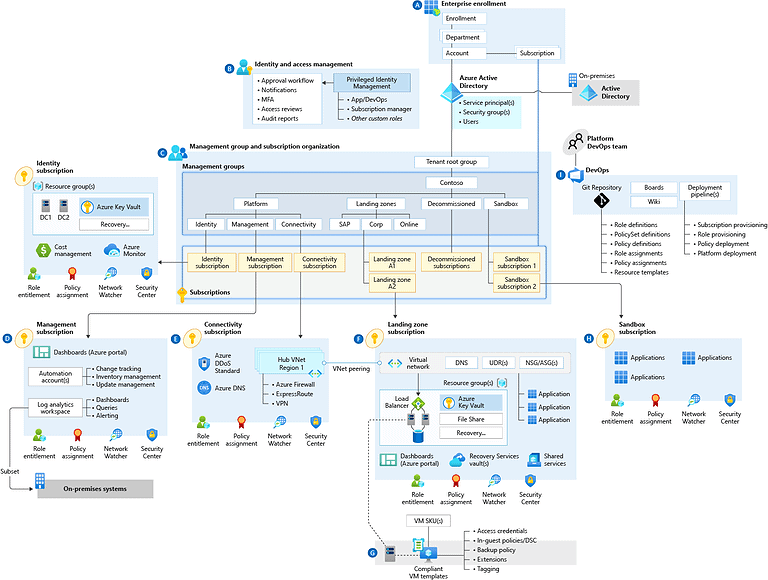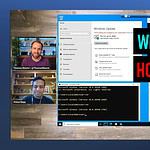If you are planning to adopt cloud services for your organization, you might be wondering how to prepare your environment for a successful transition. In this blog post, we will introduce you to the Cloud Adoption Framework Ready methodology, which is a set of best practices and tools that can help you create and prepare an Azure Cloud environment.
What is the Cloud Adoption Framework Ready methodology?
The Cloud Adoption Framework (CAF) is a comprehensive guide from Microsoft that covers all aspects of cloud adoption, from strategy and planning to governance and management. The CAF consists of different methodologies such as: Plan, Ready, Adopt, Secure, Manage, Innovate, and Govern.
The Ready methodology is a step in the CAF, and it focuses on preparing your environment for cloud adoption. The Ready methodology provides an Azure setup guide and navigates you through the process of defining a cloud operating model and creating an Azure landing zone, which is a set of cloud resources that provide a foundation for your cloud workloads.
Azure setup guide
To use Azure services for creating and deploying solutions, you have to set up your environment first. This Azure setup guide shows you how to use features that help you organize resources, control costs, and secure and manage your organization.
- Organize resources: Set up a management hierarchy to consistently apply access control, policy, and compliance to groups of resources and use tagging to track related resources.
- Manage access: Use Azure role-based access control to make sure that users only have the permissions they need.
- Manage costs and billing: Identify your subscription type, understand how billing works, and learn how to control costs.
- Plan for governance, security, and compliance: Enforce and automate policies and security settings that help you follow applicable legal requirements.
- Use monitoring and reporting: Get visibility across resources to find and fix problems, optimize performance, and gain insight into customer behavior.
- Stay current with Azure: Track product updates to enable a proactive approach to change management.
Cloud operating models
Cloud technologies have changed how IT supports the business. An IT operating model defines the factors that affect technology operations, such as business alignment, people organization, change management, operations management, governance, compliance, and security. These factors are still important for cloud operations, but they may need some adjustments. Traditional operating models focus on physical assets in specific locations, which are funded by capital expenditures. These assets run the workloads that the business relies on. The goal of most operating models is to ensure the stability of these assets. Cloud operating models shift the focus to digital assets, such as operating systems, applications, and data. This means that IT needs to rethink its processes and metrics to operate effectively in the cloud.
To operate in the cloud effectively, you need to have a clear vision of your strategic goals, your organizational structure, and your compliance requirements. These factors shape your cloud operating model, which defines how you manage your technology in the cloud. Your landing zones should align with your operating model and offer different options to suit your needs.
Azure Landing Zones
To operate in the cloud effectively, you need to have a clear vision of your strategic goals, your organizational structure, and your compliance requirements. These factors shape your cloud operating model, which defines how you manage your technology in the cloud. Your landing zones should align with your operating model and offer different options to suit your needs.
A landing zone consists of several design areas, such as:
- Azure billing and Active Directory tenant – Proper tenant creation, enrollment, and billing setup are important early steps.
- Identity and access management – Identity and access management is a primary security boundary in the public cloud. It’s the foundation for any secure and fully compliant architecture.
- Network topology and connectivity – Networking and connectivity decisions are an equally important foundational aspect of any cloud architecture.
- Resource organization – As cloud adoption scales, considerations for subscription design and management group hierarchy have an impact on governance, operations management, and adoption patterns.
- Security – Implement controls and processes to protect your cloud environments.
- Management – For stable, ongoing operations in the cloud, a management baseline is required to provide visibility, operations compliance, and protect and recover capabilities.
- Governance – Automate auditing and enforcement of governance policies.
- Platform automation and DevOps – Align the best tools and templates to deploy your landing zones and supporting resources.

These design principles accommodate all application portfolios and enable application migration, modernization, and innovation at scale. An Azure landing zone uses subscriptions to isolate and scale application resources and platform resources. Subscriptions for application resources are called application landing zones, and subscriptions for platform resources are called platform landing zones. You can create an Azure landing zone that meets your specific needs and requirements, such as:
- Scale: The ability to support multiple workloads and users in your environment.
- Security: The protection of your data and resources from unauthorized access and threats.
- Governance: The control and oversight of your environment to ensure compliance and alignment with your business objectives.
- Networking: The connectivity and communication between your resources and other networks.
- Identity: The authentication and authorization of users and applications in your environment.
- Cost management: The optimization and monitoring of your spending in Azure.
- Monitoring: The visibility and insight into the performance and health of your resources.
The following exercises help guide you through the process of creating a landing zone to support cloud adoption.
- Cloud operating model: Explore guidance on how to find the right operating model to support your cloud adoption.
- Azure landing zones: Learn about the Azure landing zone conceptual architecture and Azure landing zone accelerator.
- Journey to the target architecture: Validate your starting point for landing zone implementation against the three core concepts of start, align and enhance.
- Azure landing zone design areas: Explore the process and guidance for designing your Azure landing zone.
Want to learn more, check out my blog post about 5 Reasons to Use Azure Landing Zones for Your Cloud Migration.
Why use the Cloud Adoption Framework Ready methodology?
The Ready methodology can help you achieve several benefits, such as:
- Accelerate your cloud adoption by reducing complexity and risk.
- Align your environment with best practices and standards from Microsoft.
- Customize your environment to fit your specific scenario and goals.
- Enable hybrid and multicloud architectures with Azure Arc, which extends Azure services and management to any infrastructure.
- Learn from real-world examples and case studies from other customers who have used the Ready methodology.
How to get started with the Cloud Adoption Framework Ready methodology?
If you are interested in using the Ready methodology to prepare your environment for cloud adoption, you can follow these steps:
- Review the Cloud Adoption Framework overview to understand the big picture and the value proposition of cloud adoption.
- Explore the Cloud Adoption Framework Plan methodology to define your cloud adoption strategy and business outcomes.
- Choose the landing zone option that best suits your organization’s operating model, such as enterprise-scale or modular.
- Follow the guidance and tutorials to deploy your landing zone using Azure tools and services.
- Validate your landing zone using the readiness checklist and assessment tool.
For more information and resources on the Cloud Adoption Framework Ready methodology, you can visit the following links:
Azure Enablement Show – An introduction to the Cloud Adoption Framework Ready methodology
Successful cloud adoption is built on the strong foundations of the Cloud Adoption Framework Ready methodology. In this episode, Thomas Maurer and Dom Allen discuss how the Ready methodology can help you on your cloud journey and prepare your Azure Cloud environment.












